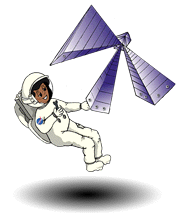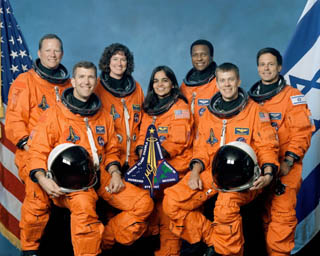![]()
 |
On the Job!The STS-107 mission was dedicated to research in physical, life, and space sciences, conducted in approximately 80 separate experiments. The seven astronauts worked 24 hours a day, in two alternating shifts. |
|
In January of 2003, the Space Shuttle Columbia was launched for what would be its final journey into space. Columbia, the oldest shuttle in the orbiter fleet, was on its 28th mission when it sustained damage shortly after launch. The extent of the damage was not fully realized until Columbia broke apart while trying to re-enter Earth's atmosphere prior to landing on February 1, 2003. All astronauts aboard the shuttle died in what was the worst space-related accident since the Space Shuttle Challenger exploded on take-off in 1986. |
|
Columbia lifted off from Kennedy Space Center at 10:39 EST on January 16, 2003. The shuttle was carrying seven astronauts: Colonel Rick Husband, Commander William McCool, Lt. Colonel Michael Anderson, Captain David Brown, Commander Laurel Clark, Dr. Kalpana Chawla, and Israeli Colonel Ilan Ramon. Over the course of the sixteen day space flight, the astronauts successfully conducted multiple science experiments.
The problem with the flight began 81.7 seconds after launch when insulation broke off the external fuel tank, hitting Columbia. At the time of the incident, Columbia was traveling at speeds over 2649 kilometers per hour and was over 20,000 meters high. Due to the shuttle's altitude when the incident occurred, no one on Earth or the shuttle was aware of the severity of the damage to Columbia. The insulation struck the shuttle on the front edge of the left wing. The damage was so severe that the Thermal Protection System on Columbia's underside was no longer intact. This allowed superheated air in excess of 2800 degrees C to enter the wing during re-entry into Earth's atmosphere at a height of 129,000 meters. The superheated air circulated within the wing, melting its aluminum structure. The wing weakened causing a loss of control. Columbia began breaking apart as it passed over California on its way to a landing in Florida. The shuttle continued dropping parts as it traversed the southwestern United States. Over Texas, the orbiter began to fall out of control at 16,000 kilometers per hour, scattering debris over Texas and Louisiana. The accident was so catastrophic that none of the astronauts on board could, or did, survive the loss of the orbiter.

A QuestionWhat caused the Space Shuttle Columbia to break up during re-entry? |
| Did you know? |
The Answer |
![]()
| Show me the Level 1 version of this page. |
The StarChild site is a service of the High Energy Astrophysics Science Archive Research Center (HEASARC), within the Astrophysics Science Division (ASD) at NASA/ GSFC.
StarChild Authors: The StarChild Team
StarChild Graphics & Music: Acknowledgments
StarChild Project Leader: Dr. Laura A.
Whitlock
Curator:
Responsible NASA Official: